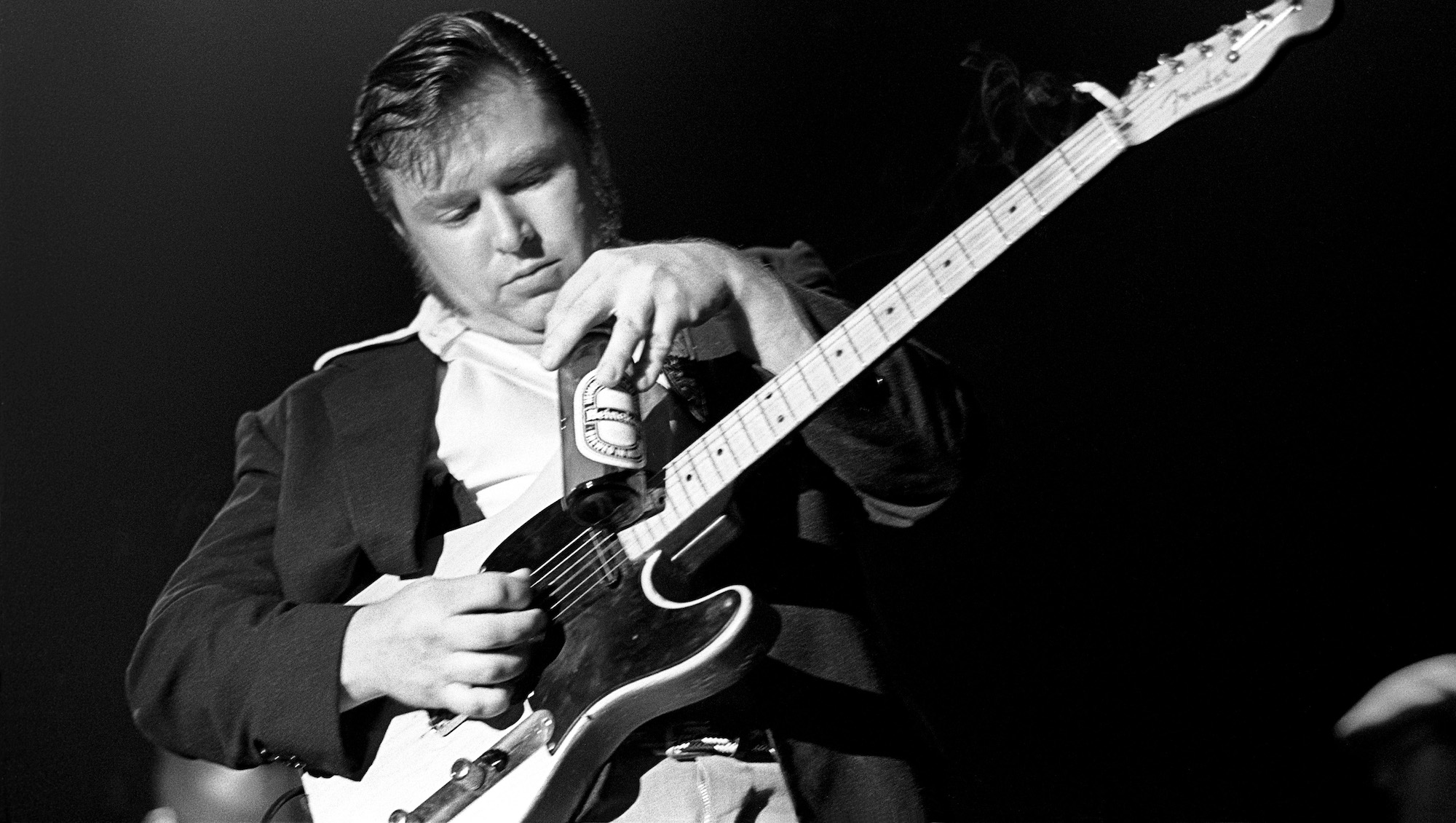Cory Wong: "When you design a guitar with Fender, you want to make it unique, so it stands out against all the other Strats"
As he releases his signature Strat, the funk virtuoso discusses the six-string’s brilliant spec sheet, season two of Cory and the Wong Notes and the most important lessons he’s learned from the jazz community

When Cory Wong describes working with Fender on his first-ever signature guitar as “a dream come true”, you get the impression he well and truly means it. More often than not, it’s a Sapphire Blue Highway One Strat in his hands, which – as we know from previous conversations with the funk star – he originally picked up on Craigslist for $300.
His loyalty to that specific guitar speaks volumes – it has barely left his side since their meeting. The new 2021 signature is a tribute to the same instrument, with some interesting modifications and customizations...
“I can’t wait to see people getting it in their hands,” he tells Guitar World. “I’ve had a bunch of friends play it and everyone’s really excited. My signature ended up being quite a bit different to the original in the end – it looks similar with the nitro satin finish in Sapphire trans blue, but those really are the main similarities.
"It has a rosewood fretboard with 22 frets, though the shape of the neck is a little more like the Ultra's modern D-shaped neck, which fits a little more comfortably in my hands.”

Retailing for $1,999, the model features a set of Seymour Duncan Cory Wong Clean Machine pickups, a scaled-down alder body and a vintage-style 6-screw synchronized tremolo. The guitars will also feature a push/pull switch on Tone 2 that will bypass the pickup selector and default to position 4 – a well-known favorite of Wong’s...
“When I play, I have quite a wide sweep with my picking hand,” continues the Cory and The Wong Notes leader, also known for his stunning fretwork in Vulfpeck. “That’s my technique – sweeping wide and using my wrist flexibility. And I end up hitting the pickup selector and surprising myself, so I got this fourth position panic button. Wherever the pickup selector is, this button makes sure I stay in fourth position.
“It was a fun idea. When you are lucky enough to be designing a signature guitar with Fender, you want to make it more unique, so it stands out against all the other Stratocasters. I’ve had this idea for a long time and have never seen anything like it. Before, I would use gaffer tape to make it stay in fourth! With the panic button, I don’t need to worry about where the selector is...”
Get The Pick Newsletter
All the latest guitar news, interviews, lessons, reviews, deals and more, direct to your inbox!
The guitar also comes with a hair tie. Another Fender first, we presume?
“Probably?! [laughs] That was something fun, I guess mainly for case candy. People have been asking about that and wondering why my guitar comes with a hair tie. It also gives a little bit of insight into how I think about sound.
"I came up with it as a rhythm guitarist, but Nile Rodgers came up with some similar things. We talked to Fender who figured out that we had some similar things we were looking for...”
Like what, exactly?
“The first is having four springs at the back. I like the feel of four because, if I break a string or tune to drop-D or tune to E-flat, it’s a bit more stable. The hair tie makes it so the synthetic vibrations of the springs themselves are suddenly muted. It responds a little more like a hardtail.
"The initial attack and transient of the note doesn’t have that breath afterwards, which of course is the typical sound of a Strat. The hair tie makes it feel a little more like a hardtail, but you still have the whammy action there if you need it. Nile Rodgers uses a hardtail and loves his for a similar reason.
“Another feature is that the body is a little bit smaller than a typical Strat. Of course, if you look at different models from the Ultra, American Pro, Highway One ranges, and all the others from the '90s, '80s, '70s, '60s and '50s – the body contours are a little different. There were small changes over the years. I wanted this guitar to be a tiny bit smaller, which did something to the sustain and attack that I loved.”

In what sense?
“It feels warmer. There’s a hard attack but it has a rounded top-end. The rosewood fingerboard helps with that, too. Nile’s guitar is also on the smaller side of the scale. He’s picked up modern-day full size models and has noticed they’re a little bigger now. His guitar is in between the size of my signature and a standard Strat.
“The average person might not be able to tell the difference. But I’m not a huge person, so the smaller body fits my frame better. The contours and shoulder fit a little easier for me. I’m able to play it for more hours than my other guitars, which is what we all want as guitarists!”
Your variety show, brilliantly titled Cory and The Wong Notes, is definitely a joyous celebration of your musical diversity...
“Yeah, you said the word joy there – that’s a big part of my vision as an artist. When you hear about a guitar player putting out an album, you’ll have a certain idea of what it’s going to be like – a lot of guitar gymnastics and a lot of overt chops. Being somebody who is mostly a rhythm player, what I wanted to do is showcase the guitar in a different way.
In Cory and The Wong Notes, I wanted to show the versatility of the guitar and what it’s capable of in different ensembles and bands
“Sure, I have chops and gymnastics, but I wanted to show the versatility of the instrument and what it’s capable of in different ensembles and bands. Cory and The Wong Notes is an 11-piece band and there’s this high energy. It showcases my writing, guitar style and my personality. The variety show has helped me show my audience, and the world in general, more about who I am, because most of my stuff is instrumental.”
Which naturally effects how the music is written and performed...
“Exactly, you don’t get to show the same amount of cleverness and wit, at least not in the same way. So the show has been great for letting that other side of me shine. We did the first season, it’s still up on YouTube, and we just shot the second season. So there’s a whole new album and actually 10 episodes this time round. I’m excited about exploring this ensemble – it’s like SNL meets The Late Show if the musicians took over.”
You recently posted a live version of Meditation, which builds from modest double-stops to some wide pentatonic fury, exploring a lot of dynamic range...
“That song, to me, is kind of like a mantra. It’s really just this one melodic idea, but a fun one! My thought was to find something that was simple and interesting enough to hear several times, and approach that line differently every time I played it.
"As a whole, it can create something really compelling. The line is compelling on its own, but the thing is when you’re playing something 100 times in a row, how do you make it feel compelling on the 29th time? Or the 46th time? Or the 88th time?
“So much of what you’re hearing is the actual moment. The band’s interaction – that’s what makes it compelling. I’ve learned that from the jam and jazz community, how you can sit in the moment. Of course you are absorbing the music itself, but in those moments, you’re hearing so much more than just the music.”
There can be a lot to take in, when you think about it that way...
“You’re hearing where every person is at in that moment, emotionally and energy-wise. You can even hear where the players are at intellectually. Sometimes it might be really brainy, sometimes it might be simple pentatonics. Both are cool. I love that about playing music – it’s the moments you can’t recreate exactly every time.”
Technique-wise, is there anything you’ve been working on or experimenting with over recent months?
“I’ve always been on this journey of finding my signature sound, finding my voice. And I started doing something that I don’t see a lot of guitar players doing – using a technique in all kinds of contexts from lead to rhythm. And the technique is simply hitting the strings with my hand. I know that sounds absurd, like anyone could do that.
"But if you listen to the intro of my song Companion Pass, there’s this triplet lick where I play an upstroke, hit the strings and then there’s a downstroke. So sometimes I might find a spot where I’d normally pick a note, and hit the strings with my palm somewhere – almost like palm muting – but a little towards the neck. I’ve been doing more and more of that, I guess.”

Given how you are usually surrounded by a lot of musicians, it’s interesting how you leave melodic space in your chords – often hinting at more than what’s actually being played...
“Yeah, I definitely like to break up the chord shapes. I’ll hold the entire E9 chord, but if I’m playing with an 11-piece band, with horns, keyboards and bass, there’s a lot of melodic information to be absorbed by the listener. As a guitar player, I don’t need to give all that information. Of course, it’s my band, so I could if I wanted to. [laughs]
“But I prefer to let the listener fill in some of those blanks. So I’ll hold that E9 but only focus on two notes at a time. For example, if you take that fifth-string-rooted classic E9 shape, I might only play the D on the third string and G# on the fourth string, maybe just on the downbeats. Then towards the end of the measure I might focus more on the second and third strings.
“When you see people playing piano, it’s all obvious – they’re playing in one spot and then moving up and down. On the guitar, it’s not as obvious, so it’s cool to imagine that you’re shifting the voicing more like a piano player just through the strings you’re emphasizing.”
- The Fender Cory Wong Signature Stratocaster is available now for $1,999.
Amit has been writing for titles like Total Guitar, MusicRadar and Guitar World for over a decade and counts Richie Kotzen, Guthrie Govan and Jeff Beck among his primary influences as a guitar player. He's worked for magazines like Kerrang!, Metal Hammer, Classic Rock, Prog, Record Collector, Planet Rock, Rhythm and Bass Player, as well as newspapers like Metro and The Independent, interviewing everyone from Ozzy Osbourne and Lemmy to Slash and Jimmy Page, and once even traded solos with a member of Slayer on a track released internationally. As a session guitarist, he's played alongside members of Judas Priest and Uriah Heep in London ensemble Metalworks, as well as handled lead guitars for legends like Glen Matlock (Sex Pistols, The Faces) and Stu Hamm (Steve Vai, Joe Satriani, G3).
“It holds its own purely as a playable guitar. It’s really cool for the traveling musician – you can bring it on a flight and it fits beneath the seat”: Why Steve Stevens put his name to a foldable guitar
“Finely tuned instruments with effortless playability and one of the best vibratos there is”: PRS Standard 24 Satin and S2 Standard 24 Satin review










